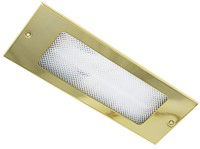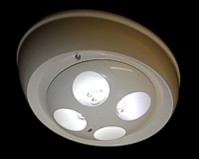In a building emergency, especially fire, fast panic-free evacuation is absolutely essential. For this reason, UK legislation demands reliable, good quality emergency lighting to ensure that people can see and that escape routes are properly illuminated. ICEL, the emergency lighting arm of the Lighting Industry Federation (LIF), explains how the latest generations of fluorescent and LED lamps provide highly effective emergency lighting:

Compliance with BS EN 60598-2-22, the emergency lighting luminaires standard, and EN50172 (BS 5266 series), the emergency escape lighting application standards, ensure that there will be sufficient illumination for people to see and be directed towards emergency exits, with exit or directional signs being in view at all points along the escape route.
Today, nearly all emergency lighting applications are fulfilled using luminaires fitted with either fluorescent lamps or the latest generation of high quality white LEDs. Both types require their own particular considerations when being used in emergency lighting luminaires.
Fluorescent lamps:
Over many years, manufacturers of fluorescent lamps, long the mainstay of emergency lighting, have continuously developed ever more efficient lamps to reduce energy requirements whilst also minimising the amount of mercury, so as to meet global environmental requirements. Such developments have been very effective.
However, the reduction of mercury in a fluorescent lamp may adversely affect the emergency lighting operation if the emergency lighting control gear is not designed to operate the low mercury fluorescent lamps - as might be the case with a lamp replacement situation. For example, the lamp may not strike, or if it does start, the slower increase in light output at switch-on may not meet the 5 sec to 50% and 60 sec to 100% output required by the product safety standard BSEN 60598-2-22. Additionally, insufficient power into the lamp could result in insufficient light output, and too low a lamp heat could shift the colour temperature to appear pink. The emergency period of operation may be reduced because of higher circuit watts demanded by the lamp. Moreover, lamps used for emergency lighting may have shorter service lives than those used for mains lighting.
These examples above demonstrate that the emergency lighting application is generally more demanding of lamps than mains operation and, therefore, care must be taken when replacing fluorescent lamps in emergency lighting luminaires to ensure compatibility of the lamp with the control gear.
The fluorescent lamp is an excellent solution for most emergency lighting applications, and simply requires high quality, fully compliant components and proper expertise from qualified suppliers to ensure that its use is implemented effectively. It is essential that emergency lighting luminaires are re-lamped in accordance with lamp information supplied with the luminaire.
Good quality fluorescent lamped emergency luminaires have the following benefits:
- Fluorescent lamps are very efficient and usually need to be dimmed in their emergency lighting mode - saving energy.
- High efficiency optical designs coupled with the greater flux enable wider spacing of luminaires.
- When the luminaires are correctly spaced, compliance with the applications standards of BS 5266 can be met with minimum power consumption.
- They have a proven performance record.
- They are economic.
LED lamps:
Good quality white LED lamps are now suitable for both exit signs and emergency lighting luminaires. Because individual LEDs are almost a point light source, light control is simple, and well-designed LED emergency lighting luminaires, with their special optics, can use virtually all of the emitted light. Therefore, the high optical efficiency of LED luminaires provides the designed illumination for less initial flux (light) than would be needed from a conventional light source.
Good quality LED lamps bring many benefits, which can be summarised as follows:
- With the right optical design they can produce, well-directed uniform light.
- When the luminaires are correctly spaced, compliance with the applications standards of BS 5266 can be met with minimum power consumption.
- They provide the basis for a high energy efficiency - up to 30% better than good fluorescents because of the more directed light output.
- They provide very long life (up to 60,000 hours at 70% lumen depreciation) with good reliability.
- They are nearly unbreakable.
- They can provide significant cost savings over the life of the installation because of a mix of energy efficiency and reduced lamp replacement and maintenance costs.
- They are unaffected by extremely low temperatures.
- They can be designed into buildings, structures and materials in ways that are impossible with conventional lighting, so provide great flexibility for designers.
The advantages of LEDs have resulted in them being offered as a user replacement item in housings that replace T8 fluorescent lamps. These should not be used in mains luminaires that have dual use as emergency luminaires, unless they are checked to ensure they operate in the emergency condition and that their light output is adequate for the emergency duty.
Installation considerations for all lamp types in emergency lighting:
Prior to installing emergency lighting and mains lighting luminaires modified for emergency lighting use, it is essential to leave batteries disconnected until the un-switched supply is no longer subject to frequent disconnection and/or switching. This will ensure that all emergency lighting luminaires do not need to be re-lamped before commissioning. Advice should be sought from emergency lighting manufacturers about the suitability of lamps to operate with their equipment to ensure full compatibility.
About ICEL:
ICEL (www.icel.co.uk) is a trade association that is the foremost UK authority on emergency lighting, and its members are manufacturers of components and products for emergency lighting fittings. ICEL's representatives serve on BSI and International Standards committees, developing harmonised product and application standards. Therefore, ICEL members are well placed to give advice on product selection and can be expected to provide good quality emergency lighting products.
Emergency lighting under BS EN 60598-2-22:
Self-contained luminaires - These provide maintained or non-maintained emergency lighting in which all the elements (such as the battery, lamp, control unit, and test and monitoring facilities where provided) are contained within the luminaire or adjacent to it (within 1m cable length).
Centrally supplied (slave fittings) - In these fittings, the lamp and some of the control gear is located in the luminaire, but the charger and battery (and often the changeover device) is located remotely, providing the supply to a number of luminaires. Central power units may supply the luminaires with a range of DC voltages, or at 230V AC from an inverter. To operate on DC, some are specifically designed as emergency luminaires; others are converted mains luminaires.

